
P.O. Box 4822, Syracuse, NY 13221-4822 • www.passandseymour.com • (800-223-4185) Printed in USA
Old Work
Ceiling Boxes
1. Cut a 3-3/4" round hole in the ceiling using either a hole saw
or a hand saw (you may also place the back of the box against
the ceiling and draw a pencil line around it).
2. Insert nonmetallic cable (stripped or unstripped) into the
Auto/Clamp
®
cable entry.
3. Pull cable through to desired length. The cable is automatically
secured without the need to install separate clamps.
4. Insert the box into the ceiling with swing bracket flat to the
box. Turn screw clockwise with screwdriver, which will turn
the swing bracket to upright position, and tighten until snug
against the ceiling. (Swing out brackets permit installation of
box in ceilings 1-1/4" down to 1/8" thick).
Wall Boxes
1. See back of box for cut out dimensions (you may place back of
box against the wall and draw pencil line around it for template).
2. Insert nonmetallic cable (stripped or unstripped) into Auto/Clamp
®
cable entry.
3. Pull cable through to the desired length. The cable is
automatically secured – without having to install a separate clamp.
4. Insert box into the wall with swing bracket flat to the box. Turn
screw clockwise with screwdriver which will turn swing bracket
to upright position, and tighten till snug against wall. (Swing out
brackets permit installation of box in wall 1-1/4" thick down to
1/8" thick paneling).
P/N 340702 Rev. C
Low-Voltage Boxes and Divider (con’t.)
Old Work Style Directions:
1. Disconnect power to circuit by removing fuse or turn
circuit breakers OFF before removing cover plate.
2. Remove wall plate on existing device if you want
to line up new low voltage device next to it.
3. Line up edge with mounting screw on existing device.
4. Mark the areas shown.
5. Connect your marks using the inside edge of
the low voltage bracket as a straight edge.
(Cut out dimensions also listed on the front
of low voltage bracket.)
6. Cut a hole in the wall.
7. Insert low voltage bracket into the wall with
swing bracket flat to the box. Turn screw clockwise with screwdriver, which will turn
the swing bracket to upright position, and tighten till snug against wall. (Swing out brackets
permits installation of box in wall 1-1/4" thick down to 1/8" thick paneling.)
Warning – To prevent severe shock or electrocution, always turn power OFF at the service panel
before installing this unit, working on the circuit, or changing a lamp.






